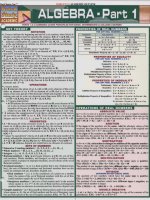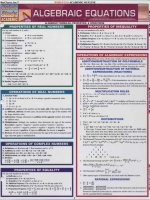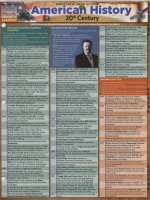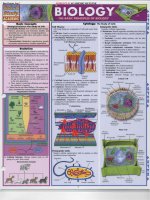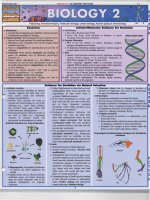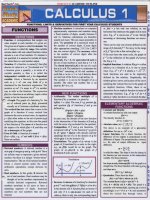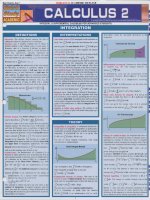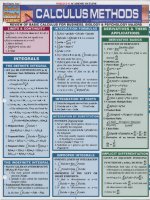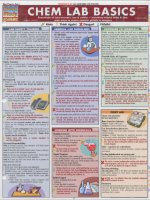Quick study academic chemistry 600dpi
Bạn đang xem bản rút gọn của tài liệu. Xem và tải ngay bản đầy đủ của tài liệu tại đây (9.16 MB, 4 trang )
----,
I
H
TI
=
1.01
3
N
=
6 .94
SYMBOL
9.01
11
5
~ATOMC
H
NUMBER
4 1
U
II
II No
'"=
WEIGHT
22.99 24.31
II
=
Of
II
=
C
10.8 1
12.01
K
21
22
Cr
Mn
Fe
50.94
5200
54.94
55.85
42
43
47.88
37
38
3'
40
55
56
41
...
28
Co
NI
58.93
58.69
45
Cu
... .,
63.55
28.09
31
Zn
Go
32
15
10
P
S
19.00
17
18
CI
30.97 32.07
33
35.45
39.95
3S
3S
34
Ge
As
72.61
74.92 78.96
Br
Se
d:< .y
Z
65.39 69.72
At
54
95.94
97.91 101.07 102.91 106.42 107.87 112.41 114.82 118.71 121.75 127.60 126.90 131.29
,.
74
Re
70
Os
77
Ir
79
78
80
Au
PI
81
TI
Hg
82
Pb
Sb
Te
I
d,
.
as
84
83
Bi
At
Po
---.., (} .--
y'---O---""
92.91
Cd
Sn
53
52
9122
W
In
51
83.80
88.91
73
Ag
SO
4'
79.90
Tc
To
*x
y.x
d,y
20.18
Mo
72
Pd
26 .98
30
16.00
10
F
0
14.01
4.00
9
Nb
Hf
Rh
29
Si
N
d -subshell
5 orbitals
Zr
57
Ru
27
AI
•
7
-----.-
Y
la'
'fI Cs
=
26
V
44.96
8762
25
24
Ti
40.08
85 47
23
Sc
39. 10
Rb
,.
13
ATOMIC
1.008
20
0
B
12
19
I
PERIODIC TABLE OF THE ELEMENTS
~x
dy7
132.91 137.32 138.91 178.49 180.95 183.85 186.2 1 19020 192.22 19508 196.97 200.59 204.38 207.20 208.98 208.98 20999 222.02
114
110
111
117
118
87
104
lOS
106
107
108
109
110
112
113
115
8&
89
I
Ac'
Fr
Rf
223 02 226.03 227.03
58
5.
Ce
Pr
60
Nd
Db
Bh
Sg
Hs
MI
261
262
263
262
265
01
02
03
64
os
Pm
Sm
Eu
Tb
Gd
.
266
Dy
Os
Uut
lAsL.. 1W4 lAse.1"'"
281
..
272
07
Ho
.
277
O•
Er
Tm
Doc i""
284
289
70
71
Yb
lu
140.12 140.91 144.24 14491 150.36 151.97 157.25 158.93 16250 16493 16726 168.93 17304 174.97
90
91
Po
Th
92
'3
Np
U
94
Pu
95
97
'0
Am Cm
Bk
98
Cf
23204 231.04 238.05 23705 24406 243.06 247CJ1 24707
251
Es
=al
101
100
Fm
102
Md No
uU~I'
288
25710 25810 2&1.10 WIll
~5
2h
,,, ".
289
293
subshell
1 orbital
27
2K
p - subshe/I
3 orbitals
~~
30
11
S-
12
33
34
v.___
103
lr
~
"
22
23
24
Z
Y~ r·l..........x
s
ATOMIC STRUCTURE
A tomk Number, Z : # or protons in the nucleus: lor neutral
a tom. Z = # or e leclrol1 S; lor all ion ol' c harge -q. Z fq cleclrons;
for calion of charge +q. Z-q electrons. M ass Number,A: A= Z + N.
the number of nc utrons in the nuc leus. Isotupes: Atol11s with the
isotopes; any
same Z , dinerent A. An clement can have a !lumber
sample contains a number of isotopes; in practical work, lise the aver
~ J\1ass Number or Atomic \Veight (\vc:ightcd average
natural
isotopes Ii)r a given element).
or
or
n: principle
L: angular mome nt um (orbital shape)
m ,: magnet ic (orb ita l d irect ion) m. : ci ectron spin
For each 11 . the possible 1 values arc O. I... n-l; lor eac h I. the po. sible
m , va lues arc -I. .0.. +/: n\ has two possible values : + II, and - '/, (spi n
up. spin down). Each val ue or n de notes a " shell" in th e al omic slruc
ture : each I denotes a subs hcl l.
s-orbital : I =0. I type
d-orb ita l: 1 =2. 5 types
p-ur bita l: 1 = 1. 3 types
f-orbital: 1 = 3. 7 lyres
Cl.: l'illlll
NUCLEAR CHEMISTRY
N uclear reactions alter the nucleus: part ides ejected or absorbed.
Balance charge and mass-energy. Energy (E) changes to mass (m).
il,lIows Ihe Einstein Equatiun: E = mc'.
Nuclide Symbol: For clement X. nuclei is symbolized by ", X or
X-A (eg. Deuterium. ; H or H-2).
Types uf processes:
Transmutatiun: New clements made li'om particle collisions.
Fusion (small atol11s com bine): H-I + H-2 - > He-3.
Fission (large atom splils):
n +U-235 => Ba-145 + Kr-91 + 3 n.
Radioactive decay:
0; decay (He nucleus):
U-23S ==> a -I Th-234.
~ decay (energetic electron):
1-131 ==> Xc-131 + ~.
'Ydeca)' (photon): Accompanied
by a,~.
Characteri7-Cd by half-life: Time
for halfofthc nuclei to decay.
r------------I
[ First ton,zation Potential vs. Z [
!
~~~
g> 3 H
5
~
iIi
I
Br
2
5 to t5 2025 30 3540
Atomic Number
''',,'' i, ,,,..
n
I
2
~ 15 ttt----,I-t-7---~7'_c: 10 r1~-+_r~--A<~--
'~
2
c:
o
5 j-.JL----c1F-----clIC==---'----I--
'c 0 ' - - - - - - - - - - -
.2
0
5 10 15 20 25 30 35 40
Atomic Number
Atomic Radius vs. Z
E ~------v-----~
3
~2X*--~~~~---~
"
ul50~~~~-~---~
';;'" loot-t----=--"'' ' ' ' - - --=
o
5 10 15 2025 30 35 40
Atomic Number
,"b~,'"Il, ",,, '""'~ ~,.ml7r
d;IT,,,"'
i
gics . The filli ng o r leve ls is guided by the
Aufbau Principle:
2
2
2
.~ 50t:· "H.------------
:;: 0 l--_ _ _ _ _ _ ___
1
00
~JiU}t~" ~5f 6d
r
25 t'H
-fe" ---""""CC-------
~ 20 tft_~N~e-~------
[ Electronegativity vs. Z
~
Orbita ls and quantum #s derived
Aufbau order for filling sublevels
lor Ihe hyd rogen atom are used to
describe all many-electro n atom s
and io ns. A more ri goro us trcat- ~,
J/, I 4.J
1
me nl ciele r mi nes exact energy lev3., I 41' ~
I 5{
e ls and o rbilal properties. The m ain
4s
i .p
2
2
2
0
0
0
0
m,
m
element
0
0
+ II,
'I,
+ II,
H
He
Li
0
0
-I
0
+1
-I
0
+1
'/,
Be
-+-
li2
B
C
+
'I,
N
i/,
()
1/:.
F
Ne
+
'I,
Ii:.
7,
Is-orbital
:-;pherical
2s-orbital
spherical
2p-orbitals
bimodal
p, p,
P,
electron configuration: Atomic orbital occupancy.
Pau li Exclusion Principle: Each elect ron has a unique sct or q ua n
tu m #s . An orbital may hold up to two e lectrons. one w ith spin-up.
In = + 1/:.. a nd one with sp in-do\'.ll. m = - I/::. .
H ~nd's Rule: E lectrons rill p. d a nd f sub-shc lls in a m anner to max
imize the num ber of un paired e lectrons (hal l~rilkd orbilals).
ionizatiun potentia l (IP): Energy requ ired 10 remove cieCiron from
an atol11 or io n. F irst IP: Removal o r ri rst va lence electron .
elect ro negativity: Tendency or an atom to al1rael electrons in a
c hemical bond ; 0-4 scale. 0 1'01' rare gas.
1
5Y
60
61
62
h3
1>4
65
66
67
hX
Pr
I'rast.:odymiliin
\Id
('m
I\! l!Od \' 1l111 1111
~ 1l1
S:IIll ~lriLlIn
I"u
I urnpillHl
l id
Ci adliliniuril
rb
TL'rhiul1\
Dy
Iii,
Eo-
Iltllmium
l)rU I1l~'lhI L!lll
J) ys pn)~iurn
I rbi Unl
69
70
71
Tm
ItlX,lJ
Thli lilllll
Yh
YllL'rhiUlI1
L li
I II"
17.1.0
175.11
17X"
Lulclillill
7.1
74
7,
71>
Ta
IX1l .~
Tanl allllll
W
IUS
T Ullg si L' 11
Rc
1 8 6 .~
/{hi:l1IUIl1
o~
19(}.1
OSlllium
77
II'
\92.2
\95.1
\9 7.0
Jridillin
n
7X
1',
7Y
XO
Au
~I
Il g
rl
r'b
J1i
2UI).6
204.4
207.2
20 Y
209
210
l1ali li mll
PlaLilllllll
(.u ld
Nlcn.:ury
Th:lllil lin
Lead
Ui~mul11
PUI Olliulll
~ -('2' -
TYPES OF MATTER
-
•..",..
Chemical Formulae
Cation symbol . followcd by anion.
Subscripts denote relative composition.
Enclose polyatomic ions or molecules in parentheses.
MEASUREMENT Be UNITS
Mol~cular
Formula: Discrete molecule.
Empirical Formula: Relative molar ratio of elements
rnass: Kilug ramlkg) = 1,000 g 2.2tJ46 po und .
I~ngth: Meter (111) = ItJO em - l .tJ93 6 yard = 10 '" A.
time: Sec ond ( s ); temperature: Ke lvin (K ).
T(K) = T( "C ) + 273. 15
T(,' F ) = "I"
T ("C) . 32
for solids or molecules.
formation: Elements to compound; C + 2 H, => CH,.
combination (synthesis): 2 substances ">rIn a-new substance
2 Na + CI , = > 2 NaL'1.
ox idation~reduction: Oxidation states change
(sec expanded section. pg. 3).
acid-base neutralization: Form water and a salt
(sec expanded section. pg. 4).
decomposition: I substance yields 2 or more substances
2 HgO = > 2 fig + 0 ..
displacement: Elcnlent displaces another cicment from a
compound; Zn , 2 HCI => H, + Znel , .
double displacement or metathesis: F:xchangc anions. tonn
precipitate: NaC I (aq) + AgNO,(aq) => AgCI(ppt) f NaNO,(aq).
combustion: Exothermic reaeiion with oxygen: C + 0 , => CO,.
PHYSICAL PROCESSES
melting (s = > I): (j'ecz ing (I = > s)
(at I atm. normalmclting point "T " )
evaporating (I : : ;.> g)~ condensation (g => I) III
(at 1 all11, normal boiling point " T,,"')
sublimati o n (s = > g)
solution formation = mixing 01' gases. liquids or solids.
distilla tion: Separate
mixture hy selective
Liquid
Solid
evaporati on.
_
trip le p oint:· s. I. g in §
equilibrium ·'T."
~
,
Q)
Gas
"apor pressul-e: Thc "
partial pressure of the :2
gas in equilibrium,t
w ith liquid (depe nds
on
temperature ):
eq ual s I atm at "T h ."
Monatomic Cations
Alkali metal (+1); alkaline earth (+2)
Boiling
water
_mJ:____ __ __
j.QQ"j:'; - - - -- -
Transition metal: Valence varies, give the valence in the
name and formula: "ous" or "ic" ending. Roman numerals
are less confusing. more general.
ferrous. Fe (II)
ferric. Fe (III)
Body
temp.
Room
temp.
Freezing
water
_ge~c ____ ____ _
;)l'~
J2e:C_________
;;>Q.' ~ --- - - -
stannic. Sn (IV)
plumbic . Pb (IV)
cupric . eu ( II)
mercuric. Hg (II)
stannous, Sn (II)
plumbous. Pb (II)
cuprous. eu (I)
mercurous . Hg (I)
@Polyatomic cations
ammonium , NH .. +
hydronium. H,O+; active
f(lI'Ill
@
@
8)
oxide.
nitride. N
.1'.
°'-.
Prefixes :
tera T (10 12 )
kilo k (10 ' )
micro ~I ( Itt" ,.
phosphide. P ]'. arsenide, As .,.
Br~.
iodide. I . Acids: hydro -fiuoric, - chloric. ·bromic. -iodie
Polyatomic anions (& respective acids)
8)
acetate, C,HP',
nitrate. NO.;
nitrite. NO, .
hypochloritc. ClO
chlorite . CIO,'
chlorate. CIQ,'
perchlorate. ClO;
cyanide. eN'
acetic acid, C,H,O,
lIitric acid. HNO,
nitmlls acid. HNO,
inpach/ul'Olis acid, HCIO
chlorolls acid. HClO,
ch/"ric acid. HClO,
perch/oric acid, HC/O,
hvdrocv{/Ilic acid. HeN
./i)rmed h.\' hases ill \l'ater
hydroxide. OH '
bicarhonate or hydrogen carbonate,
Anion. cation names derived
from clement na mes.
Orga ni c: Separate namin g sy s
tem.
m ega M ( 10")
millim(I() ' )
"ico p (1 0' '' )
A . Electronic P roperties:
dihydrogen phosphate. H,P0;
permanganate. M nO;
@
carbonate.
cot
sulfate, SO,"
sulfite, SO , ,.
@
phosphate,
di pulf mo m en t (~.): Positio n o f the molec ular l.!icctrt1 n ul!n
sity. relative to the cenll:r ~)r l1la~s: im parts part ial l:hargc. to
thc molecule: /1= 0 for symmetric (II ,).
,.. > 0 for asy mnu'tric :
carhonic acid, fi, CO,
SII/fill'ic ocid, if, SO,
slI/fimJl(s {/cid. H,SO,
chmlllic acid, ff,O-o,
O+H _ Cl e
pola rizability: Tcndclll:y of l:h:clron c10UlJ to distol1 fmm equi
librium due to external ckc lro~ talics : inl' reaSl'S with atom size.
B. Intermolec ular (be twee n m olecules)
s,ot
'
po.,"
-
p/IO.' phoric acid, H,PO,
@
silicate. SiO, ,~
R = R.J I4.1 n1Ole" K ' (Io ren c rgy ca lculati o n)
R = 0.082 I atm mol e" K ' ( for gas pr"pe rty ealclliatinn )
Avogadro'S Numher: N, 6.021 x 10" mo le " .
Boltzmann constant: k Rf N, U RI , In " J Illolcl'ulc-' K·'.
E lementary cha rg" of the el,'ctron. e : 1,(,02 x I (J ,,' C .
Faraday C onstant. I : c h"r~c o f N c !cct runs.
Mass of a proton. m : 1.6 73, 10 ," ku.
M ass of a neutron, m,,: 1.675 \ III 27 'kg .
Mass of an electron. m : 9 . 110 \ 10 " h! .
Planck's Constant, h: (~.62(, x 10 " .I s.
Speed of light in a vacuum, c: 2. 9 97 ~ \ Ill' m s·'.
CHEMICAL INTERACTIONS
H C O,~
bi s ulfate or hydrogen sul l'a te. HSO;
biphosphatc or hydrogen phosphate. HPO/'. dichromate. C r,07 ,.
thiosulfate.
(thio: S subsl. tor 0 atom). disulfide. S, ,.
Che mical Names
Sta n with the "cation" name,
1l,lIowed by "anion": use pre
fixes to cl arify any ambiguity.
~iga (; ( j(J")
centi c (1 0 ")
nano n (10-")
"
Fi nd the whole-numbe r coeffici e nts which give the same
amoun t or each e (cment on each s ide of the equa tion .
NOMENCLATURE
Kelvin
hydride. H . halides: fluoride F'. chloride C I '. bromide.
chromate. C rO, ,.
perox ide. 0, ,~
Remem ber: Always c hee , your work I Make SLlre that the
same number of cach type of atom and the same to tal charge
are o n e ac h side of the equation.
Ce lsius
sulfide. S " . selenide. Se 1-. telluride. Tc z
HINTS FOR BALANCING
EQUATIONS
Iden tify eac h elem e nt involved in the reacti o n.
Cha nge eoelTicients o nl y. not the formulas.
Apply coc lTici c nts to eac h atom in a polyatom ic ion.
Dete rm ine the net c harge lor e ach side of the equation:
Must be balanced in th e I'inal equation.
Start w ith th e e lem e nt appearing once on each s ide .
Nex t. focLl s nn the m ore co mpl ex compo und s.
II' an e leme nt appears in a pure form, leave it to the last step.'
It may help to use fraction s to balance. th e n convert to
integer coefficients n!'te r all elements arc balanced.
Fina l step. make s ure c(Je lTi c ients are the smallest whole
numbe rs.
- 293 K
___ _____ _ O:C________ ___ - 273 K
Fahrenhe it
Monatomic anions
carbide. C .... silicide. Si'"
--310 K
volume: I iter (l) = 1.0110111 L - 1.0567 quart.
pressure: Pa scal. Pa ( N/I11"): I a tm - 101 .325 I'a .
force : 'l e wton , N (JIm) ; chargc : c·Qulomb. l'.
energy : .I o ule • .1 (kg 111 '/ s' ) = 0 . ~3 901 ca lo ri e .
of acid in water
@
_~;;>: c
-· 373 K
_______ __
,i/icic ucid. H,SiO,
Londo n Forces ( DiSI)Cr sion): t\t1 radion o r Ind uced-dipole
tnOT1l em~ ; stronger fll r ll1C.wc polarl/ub1c ~pccies: nCl!OU nb
1;:'11' liquc:faction of g
forces for ccnain rdlli\c ori~ntntion:{. 13ascL1 Oil ~k-eLr(i~wtir..: furcc~.
s+ S- S+ 1'
0+ o· S' 0+
... ..
... ...
stable
less stable
hydrugcn-bond in~: En hant.:~J u ipo l (.;-i ll t~r;lt:tion hctw""""ll hydro.
gl.!l1 (i r an -011or -N i l gr(Jt!p arid a Ilc.:alt)y oxyg~lll)r nitrogen atolll.
cl('ctrostatic : trong intc.:ral:lion lX'h\il.'l.'i l iuns: allra~l i\'\~ (oppn
~itc charg~:t;) or rcpulsiv(' (/ 11.. (: I.: hargc.:s). Im cr"ldy prop\lrtivn:ll
to di ~tancc and dielectric ~{)list n nt of i ht! llll.'d iUTll. Wakr h~l . . 3
Reaction eq uat ion i ~ a mo lecular eq uati on; the ma Sses or
indi vi du a lm o kcul es a re too small for ro utine usc . The m ole
(Avogadro's nu m ber or atom s. particles or molecules) gives
a morc usable qua ntity.
The molar mass of a ma terial is the mass ( in grams ) o f I
mole of the m ateria l (the for m ula weight or molecular
weight). It is determined by summing the atom ic we igh ts
lor the cle ments compris ing thc material , weighted by th e
I'o rmula coefficients (e .g . I mille of carbon -12 is 12 .0
gra ms).
I3.rge dielectric co n~tant. stabili7cS ion l~)rm!liion in soluti pll.
C. C hemica l bonds ( bet,, ~~ n atom s in llIo l ~cu l es)
val ence electro ns : The outer det:tro ll:-; \\ hi ch form thcmical
bonds. The rl.!:--l of !hc clcdrons ( inIH.:r- ... hL"ll) flrC 111l:rI curl'
electrons. Bonding is described wi th th ree idea l modek
covalen t bond : E lcct ron~ an: shared: the pohtrity of th ~
bond denotes uncqun l " bari ng an d 1:-; dCkrm incd by the l'il.'~
truncgati vity o f the ntOlll~; J1u re-cov::.tIent: ! ~qt1nl :-;hnnng.
ionic bond: I-.. Ic:ctrustatic inlcr,l(..t iutls iJct\\\..'i.:1l ion:-: : i.:reat",'ll by the UUllS
ter ofelectrons bcrvvecn atom.., to create! kIllS \\ ilh fil led \ ....iL·mx· :..hell....
metallic bond : Electron, arc do loc"li7c(1: Shored by n la rge
num b!.!r ofmdn lJ ic nuc":i .
real bonds: P:\rtially covnkntlpartially ionic. Dil1l:I"(,JlcC in
ch.!clroncgativity dClcnn lllCS the t~'D i\lll ic L"ilar;ll..:tcr.
T he balanced molar equation can alsll be viewed as a bal
a nced m o lecu lar eq uatio n. with the coen-icicnts inte rpreted
as m o lar qu a ntities.
theoretical yield: M ass of prod ucts is determined fro m
mass of reactants. mo lar masses . and balanced equation.
lim iting reagents: For two or more reactants. the OIlL' con
s umed fi rst will limit th e amount of product.
solution c alculation: N umber of mol es = solutio n volume
(i n lite rs) x th e m o lari ty (mo les per li ter) o f the reagent.
2
I
Io n ic Cha racter
::::;:=
0.5
'!zzTf¥ ,
1
1.5
2
2.5
3
Electro negativity d ifference
3 .5
Real gases violate the Ideal Ga s Law.
FORMAL BONDING MODELS
Lewis Structure: Visual represe ntation of a molecule. with
the valence electrons (dols ) allocateel as bonding pairs and
non-bonding lone pairs.
g::g
H:H
: ¢I : 9.1:
Particle-Wave Duality: Electrons and lighl exhibit waw and par
ticle character. The wavelength (A) of light desclibes the "color,"
related to the fj'cqucncy (v) and spced of light (e), by AV ~ c: the
energy of light is quantized in photons, hv (h, Planck's Constant).
In simple form, the electron wave-property is described by the
deBrUJllic mooel: the A is related to its mass (m) and velocity (v)
by A = h/mv. Eleclrons in atoms occupy discrete energy levels
and are described with quantum numbers and wavel ike atomic
orbitals (AOs). The Autbau principle guides the tilling or Ihe
atomic energy levels. The complete description of the wave char
acter is termed the wavefunction 1jf. The AOs give IjI lor an atom.
H : 9.1:
Octd Rule: Atom s surrounded by 8 electrons, forming
4 bond s (exccpt H, which will have 2 electrons, and
atoms with d-orbital s, which can form 6 bonds. e.g. SF,,).
multiple IKlnds: Bonded atoms may share 1,2 or 3 electron pairs.
bond order: The number orbonels lor an atom divided by the
number of nei ghbors. Single bond (order 1.0). doubl e (2.0),
triple (3.0), may be fractional. For a given bond type. bond
length decreases with increasing bond order.
rL'sonance: If dillcrcnt Le\vis structures arc possible. their
avcrJgc is the more accurate view of the bonding. Resonance
dclocalizcs electrons and stabilizes energy.
For example . Ozone (0 ,) has hvo resonance structures :
:¢?:q::g -
MOs give the IjI tor a molecule; each MO is a linear ClJmbi
nation (weighted sum) of AOs.
Overlap of atomic orbital lobes with the same sign gives con
strw.:tive interference (bonding interaction); overlap of
orbital lobes with opposite signs gives destructive intertcr
enee: A less stable arrangement termed anti bonding.
9::q:9:
VALENCE BOND THEORY
-
-
-
-
:
o
__ __ _
.
-=-- _. _
.
=-___ __
_
=
~
_
.
~
--"---=
_
formal charge: Denotes an atom has gained or lost valence
electrons, relative to the li'ee atol11. Calculated as t(lilows: ( #
of valence electrons in li'ce atom) - ,/, ( # bonded electrons)
( # lone pair electrons ). Other things equal: Structures with
smaller formal charges arc morc stable, place negative charge
on morc electronegati ve atom.
'.,
s
I
S
~
~
A chemical bond IimllS by the overlap of singly-necupied
valence atomic or hybrid orbitals. The resulting pair of elec
trons lorm the chemical bond.
1s
1s
81
a '~ ~
rVT data d~)es n OI fit Jd.: aJ pr~ dil:ti o rh .
• Gases liyucfy at low r and high P_
• Mulcclill's haVl' rotational anti vibr.l liunai energy.
The van del' Waals etluation improves the Ideal Gas model:
adds terms t~'r 1l1l1]ecuiar volume and inlcnnl)lcl'uiar ntt rn('ti(m~.
MIXTURES 8& SOLUTIONS
Phvsical com bi natio n: So lule (,ulid or les 'cr amount) dis
sol~es In the so lvent (liquid or i3rger amount) .
lujul' Factor Promoting 1\1ixing of Fluids:
nll\ture is
more disordered than ,cpara te pha,cs.
Variable Factor: Interaction between materials. "I ike-dissohCs
liI,c"; po lar materials mi'l (miscible), u.s do nonpolar. Pular and
nonpo lar arc usually immiscible (furm sepanlte liquid la)cn».
Solution un ils :
M: Mola r ity - moles of solute cii"ol ved in I lilcroi'soluuon.
Ill: Molalit) - l110 les of so lut e per kg or soh en!.
x: Mole fraclion - 1110 le of so lute divided by tMal l11ules.
colligative propel·ties: Depend only 0 11 the llul11ocrot'solute par
ticles lind the iden tity of the solvent. Ionic matelinls tlis"x:iatc.
vapor press ure lowering:
L1 P = X.....1U1O: pO (solvent vapor prc;,surc).
freezing pt. dc pres~io n :
.1.T= - m,,1l111.:k rp (con ~ta l11 depl'nds on "iu!n:nt) .
bo ili ng pt, elevalion :
Il.T= m"",,,k hr (constunt de pe nd s all ""hem).
osmotic pressu re:
M ~(/ltU~ RT.. R is the Ideal ,as constal1l; account\ f'o r tur
go r pressure in rl unts and ' hapc in animal cells.
n
G,
Interactions
on
th e
bond axis are termed
a: ofT ax is arc termed
rr. Antibolllling inter
action s arc notL'd IT
and G' .
H, molecule
rr'
A
Geometry: Valence Shell Electron Pair Repulsion
Theory (VSEPR): Optimulll arrangement of bon tied
neighbors (X) and non-bonded or lone pairs (E). All
structures arc derived from ideal arrangement of X 1 E
objects ahout central atom.
AX 2
linear
J.l=0
Hybrid=sp
BeCI 2
AX 3
trigonal planar
Hybrid=sp2
BF3
~I=O
bent
A~l
eF 2
J.l>0
tetrahedral
AX.
Hybrid=sp3
CH.
J.l=0
trigonal pyramidal
AX3E
NH3
J.l>0
AX 2E2
bent
H2 O
J.l>0
trigonal bipyramidal
AXs
PF
Hybrid=sp 3d
~I=O
seesaw
AX.E
SF.
J.l>0
T-s haped
AXl2
I 13
J.l>0
AX 2E3
linear
ICI 2J.l=0
AX 6
octahedral
SF
Hybrid=sp 3d 2
~I=O
•
AXsE
SbSt
AX.E 2
IF. -
square pyramidal
J.l>0
square planar
J.l=0
+
o·
+
produces an accumulation of electron
density in the bonding region.
+
P: Pressure is the force/area exerted on the container walls
(in atm, mm IIg, Pal. V: Volume of the gas sample (in liters).
T: Temperature (in Kelvin) n: Moles of gas partide,.
R: Ideal Gas Constant STP (Standard T and PI: I atm;
273.15 K. one molc ortdeal Gas occupies 22.414 liter.
Bovle's Law: P x V is a constant lor fixed T: p ~ IN
Ch'arles' Law: V ~ T fixed P Avogadro's Law: V ~ n.
i!m
,:ijj·,w
+
·0
1.~
.atiffl.;;.
:::J12
-1.
~o
:J
o
O.
0 0 .4
> 0.2
0·00
200 400 600 800
Pressure (mm Hg)
+
3
ox idat ion Ilum bers c hange.
View reaction "A + B
A U" in two stcjls (ha lf-reliction,) :
t'irst oxid ation: (A loses elcctrons!. A ~ A
thell . reduction (B gaill s e lectn",,), l3 + e - B.
A + B I(lnll th e pmtluct Al3.
\ all.!ncl!: hil lnnt.:\!
C k C ln)J)-c\t h ang~.
Foracidlc: Usc II () anJ II ,0 II) hakJl1cc. For Ixt"ie: lisc Oil
aJ1~
fLO.
Exam ples of redo\ reactio ns
battcry/gaha nie : Z n(s) ~C u (a'l ) > Ln' laq) + CutS)
electroly Sis. 2 110 (I)
2 II , (g ) 0 , (g).
c rrosion: 2 AI (s) 30'(g) · 2 AI, 0, (s).
combu sti on : C 0,
CO,.
dectrochemical cell: An ex ternal CirCUit connect> t\\U elec
tmdes (anode - ,i tc uf Ll\idalion. anti ca thod e - sile of
reduction) 10 fac ilitate the reaction.
cell E MF: Electrical potential generated by the cell:
f
> ()
for sponta ll!.!Ou:, proccs::,.
100
200
300
400
Temperature (K)
Ideal Gas Law: PV = nRT
Model relationship tor describing properties of a gas sample.
Non-interacting massless particles. Good for low P, high T.
velocity and energy: The kinetic energy of I mole of Ideal
Gas is 3/ 2 RT; the velocity (rms) for a gas with molar mass
" M" at a given T is (3RT/M) ' , (the average speed of a typi
cal gas molecule ranges from 400-I,XOO m/sec at STP).
Graham's Law: Rate of effusion is ~ l i M ' ' (Etfusion - gas
expands into a vacuum); also fits diffusion j()r low P (gas
mixes with other gases , with molecular collisions) .
2p,
oxidation #: Element (0), ionic substance (charge of the
ion), covalen t compound (charge on atom if all "lienee
electrons shi n to the more elec tronegat i\e atol11).
redox chemistry: I.kctr(lils arc exchallged in the reaction :
Bal ancinl( Redox Reactions: Tvv" eOl11lllon approuehes:
I. lJalr-Reaclion ~I c thod : IJala nce Ihe reduction and o.\ida
lion "hal r-rL'Ul:l lon:,: ' ClHllhillC. \\ it h electron l1(m halalll:t.!J.
o Oxid:lHnn-N umber Method : I~e n lily change, In elements
BEHAVIOR OF GASES
>0
_ _7-£>.r
~
+++
+
A diagram of MOs gi ves energy level s 0 *2s
for electrons in the molecule. As for
AOs, each MO can have at most 2 c1ec- G2s
trons (with paired spi n).
2
The bond order is given by (# of bonding electron pairs)
( # of antibonding electron rairs).
.g2
S, p, d and f AOs can mix or hybridize to form equiv
alent lone pa irs and bond ing pa irs orb ital s. Supports
VS EPR model. S and p can hybridi Le to sp (2), Sp l (3)
or sp' (4 equivalent orbi lal,); d orbitab expand the
options to f ive (sp'
++
The MOs describe the electron density
and energy. The bonding int~raction
A+ + Electron
gal va nic (vo llai c): pontancolls reaction produces a
current; u,;ed to make batteries.
Diagram fo r Zn, eu ce ll : Zn(s) I Zn' (aq)
nO\\
of
II ClI' (aq) I (lI(sl
Oxidation-Reduction continued
electrolytic: Exte:nal currentivolt-
> HA + OH (basic, ego
fOlming OH- or H,O : A + H20 <
F- or acetate); HX + H,o <-> X + H,o' (acidic, ego NH, ).
butTer: A solution of weak ac id and a salt of its conjugate base
or a solution of a weak base and a salt of its conjugate acid. The
mixture maintains "constant" pH, Henderson-Hasselbalch
equation for an acid/salt buflcr: pH = pK" t log",([salt]/[acid]).
acid- base titratio n: React a known amount of acid with
a basic solution of unknown concentration.
At the equivalence point : a. mo les of acid = the mo les of
base . b. For stTOng acid-strong base titratio n , pH = 7. c.
For weak acid-strong base titration, pH > 7. d. For weak
base-strong acid titrat ion, pH <7 (Hydro lys is of the sa lt
io ns c hanges the pH of the solutio n).
Reactions: Acid-rain: Sulfur and nitroge n oxides react
with water to give acids . Strong acid/bases react with
meta ls, produce H, and saiL Carbonates are decomposed
by ac id. Copper + ni tric acid produces nitrogen ox ides.
Electroly sis of molten NaCI
age drives the reaction. Baltcry
powered e lectrolyt ic process.
For E < 0, reverse is sponta
neous. AG = - n Jt ( 7, Faraday
constan t, " n" mol es or e lec
trons ); reverse' reaction, change
the s ign of the potential.
Standard poten tial
EY :::: Etlan",!.:
+ EO(.';!lhmJ,:
Inert
Reduction pote n
tials: Standard tab
ulation of e lec trode
half-rea tions (writ- 2 CI-(I~ CI2 (g)+2e- 2 Na+(I)+2e-- 2Na(l)
ten as reduction).
Re feren ce potential: H, electrode O.OU V
o Non metals: E, + 2 e~ => 2 E-.
A larger, positive numher is evide nce of a more reactive materiaL
Fo 2.87
I, 1.36
Br, 1.09
1, 0 .54 .
o
Metal s : M ' (aq) + x e- => Metal.
T he positi ve value is evi dence of a less-reactive metal.
Ag(l) + 0.80 C u(ll) + 0 .34 Pb(") -0.13 Ni(ll) -0.26 Fe( II) -0.45
AI - I. 6
Mg -2.37
Na -2 .7 1
Li -3 .04
Zn -0.76
o
o
o
acdatt:
c hlori(it:
nitrate
bromid..:
fluoride
s ulfate carbonate
sulfide
oxide
phosphate
hydroxide
perchlorate iodide
chlorate
o
chromate
alkali
llll'lals.
i.iJl1lll0n iUlll
Ca. Mg
Sr. Sa
rc, Cu. Z n
Pb(ll)
Hgtl)
Ag
rSOlu~~e
lIlso1
IIlso l
Illso1
Insol
Illsol
form
hydrox
s
insol
s
inso l
insol
insol
insol
ins-ol
insol
insol
insoi
ide
insol
insol
insol
insol
insoi
insol
Flame test:
Characteristic colors of ion in a name:
v io let:
potass ium , rubidium, cesium
blue:
copper (aLure), lead, arsenic, selenium
g reen:
copper (emerald), barium (yellowish). zinc (whitish)
ye llow:
sod iulll
red:
lithium (carmine), strontium (seariet), calcium (yellowish)
ACID-BASE REACTIONS
Self-ion iz ation o r water: 2 H1 0 <=> OW + HJO+
K" = 1011-IIH,o' 1 = Ixlo- I' at 25"e. For all aqueous solutions.
Ne utral solutio n 10H-1 = IH,O+ I = IxIO-7
pH = -log lII[H , O'I: A measure of acidic stre ngth: Neutral
solutions, pH = 7; acidic, pH < 7; bas ic, p H > 7. (eg. a 0.01
M so lution o f H, O has a pH of 2) . pO H (pOH = - loglu[OH-])
c an be used for basic soluti o ns. p H + pOH = 14.
Acids (HA ): HA + 1-1 ,0 <=> A- + H, O .
A- is Iii" coni l/gale "ds" ()/' Ihe acid HA .
Strong acid. total dissociation: HC I. HBr, HJ , HClO,. H 2 S04
and IINO, .
.
Acid equilibrium is desc ribed by K" = [A-][ H,O ]/[I-IA] .
Weak acids have K. « I. pK, = -loglII(K,J.
Common weak acids (p Ky acetic (4 . 19 ); IIF (4. 15); nitrous
(3. 35): ca rbonic (6.37 ).
Lewis acid is a n electro n pai r accepto r.
B ases (B): MOl 1 <=> OH- + M .
B + H,o <=> HB + OW
HB is the cOl/iI/gale acid oI ,h" hase B.
Strong base, complete dissociation: NaOH , KOH and Ba(OH)2'
Base equilibrium is described by Kb = [OH-][HB]/[B].
Weak b ases have Kb « I. pKb = -Iog"i Kb). Common weak
bases (p K,J NH, (4. 75); C N - (4.70).
Lewis base is
e lectron-pair donor.
Polyprotic acid: A co mpound wit h mo re tban o ne ionizable
proton (eg. H,SO"H, PO,).
A m photeric s ubs ta nce: A material which can react as an acid
at;
or a basco
Hydrolysis: Water + aqueous ion => ac idic or basie solution by
..1C = (sum ofpnx.lud.1.(i\!) - (sull1ofrei.lctant ...H .3'I')
o
Reactions to completion: All reactants are converted to
products.
Equilibrium: The reaction reaches a steady state of for·
ward and reverse reactions.
For: aA <=> bB: The equilibrium concentrations of
reagents, [At, and [B],." arc constrained by the re lation
ship: K'G= [Bt,b/[At,"· K,q is a constant, characteristic
of the reaction at a given temperature.
Solubility Product, K,p: Defines the equilibrium
between a salt and its aqueous ions; for AX " the equilib
rium is AX/s) <=> A" (aq) + 2X-(aq), a;"d the K" =
lA' -][Xl'; small K,p = low solubility.
LeChatelier's Principle: The equilibrium shifts in
respon se to changes in temperature, pressure or reagent
concentration. A < = > B; removing B or adding A shilis
equilibrium towards the product.
For increases in pressure, the equilibrium shitts to lower
the total pressure (increasing the pressure raiscs the con
centration). Most rele vant for gas-phase reactions.
Exothermic reac tion produces heat: ";\ <=> B -t heat" ;
lowering the temperature removes heat and shifts e qui
librium towards the product. Rai sing the temperature has
thc opposite eflect.
Endothermic reaction absorbs heat: "Heat + A <=> B";
raising the temperature adds heat and sh ifts equilibrium
towards the product. Lowering the temperature has the
opposite effect.
E, ) ~
j)
4
~Tra~tate
r'H
®Reactants
~--. J~~
Prod~ ®
Reaction progress
KINETICS
Rates of Chemical Process
h8 > cC + dO. thl' rate
usuaily depends on IA] and [13J.
First-order rate law: Rate - ', fA] "" k,[B] .
A g raph of " ln[:I vs. time" i:-. l i llL'ar, tll(.' s lope is the
rate-constant k l .
For a generic reaction: aA
half.life~ I I~ : Th..: lilll": n: quin::o for th e co ncentra
tion to decrease by a fact o r ofe . t l, O . 6~ 3 ' I: c\:
Radioactive decay.
Second-order rate law: Ratc - qAl' or k [B I'
A graph of ""I I VS. time" line,nc slop,· is lh,' ratc
constant k,.
Half-life ciwngcs durin g the rc.=action.
Zero order: Rat e - kll[A]" = kll'
The rate is indepe ndent "I' [AJ. NOh': IAI"=1.
Temperature-dependence of rate consta nh
Arrhenius Law: k = A e- I :...•K1 . Ea is the- activation
encrgy (cnergy barrier): a gl"ph of "In(k) \.,. I r
is lincar, !>.Iop.: is -LlI R. and the intc.=R"Cpt i, In( A).
Kinetics and Thermodynamics
A <=> B: K fll = .. 1/k· 1 ,k 1 is forward-rat,· con, t,lnt
and k., is re ve rse-rate Constant.
CREDITS
Author: Mark D. Jackson, PhD.
Artwork: Rich Marino
Layout: Rich Marino
THERMODYNAMICS
The study of the heat and work associated with a physical
or chemical process.
o Types of Processes:
Reversible, the system is in a state of equilibrium.
Spontaneous (irreversible), the system is moving towards a
state of equilibrium.
o Laws of thermodynamics:
First Law - conservation of energy, (U): The heat (q) and work
(w) associated with a process are interrelated: 60U = q+w. Any
change in the energy of the system must correspond to the
interchange of heat or work with an external surrounding.
Second Law - entropy, S, is conserved for a reversible
process. The disorder of the system and thermal surround
ings must increase for a spontaneous process.
Third Law - entropy is zero for an ideal crystal at T=O K.
The system is in its lowest possible energy state and most
ordered arrangement.
o enthalpy (H): AH is the heat absorbed or produced by
a process under conditions of constant pressure (normal
lab conditions).
6.H<0 for an exothermic reaction and >0 for endothermic
Enthalpies of Formation, 60 H V: The 60H for the synthesis
of the compound from standard elemental !orms at 25"C.
Note: These quantities can be either positive or negative
60H = (sum of product"" H l!) - (sum of reactant ~ H ~ ).
o entropy (S): Thermodynamic disorder:
LlS is the change in order in a system. For s => I or I =~g, 60S
is positive (the product in each case has more random motion).
Standard entropy, S': The entropy of a compound at 25"C
--
The equilibrium constant. K•.•1, and ,L),G arc
relatcd by the equation: 60G = -RT In(l":,../
EQUILIBRIUM
PROPERTIES OF
INORGANIC SALTS
Aqueous Solubility:
relative to 0 K. Note: Hu!se {llICll1lilit:s are 1I1m~IS {)(}\'iti\'l'.
60S = (sum of product S") - (sum of rl'actant S").
Gibbs Free Energy (G): AG All - Til:;.
6oG: The capacity of the system to perfo rm \\ ork.
6oG=0 for equilibrium. AG<O Illt· spontancou>: If
~G>O~ the reVerse process is ~ ronIHnt:Ol1s.
Free energy offormation , ~ (;:' : The Gre,l'
the synthesis ofthc compound from standard
elemental forms at 2S"C.
NOTE TO STUDENTS
This QuickStudy" guide is an outline of the principles of
Chemistry. Keep it handy as a quick reference source in the
cl assroom, while doing homework and as a memory refresher
when rev iewing pri or to exams. It is a durable and inexpensive
study tool that can be re peatedly referred to during your
school years and beyond.
\11 r i\:hh
I"'"
I't'O;O:·I'\~d.
'-.0
I'~rt
01 thi.
m~~n'. ~ l«:I,\lt1Ic \If 1!"· ,,h.n,.. ~ 1
ptJhh~~l1on
lOlL' h..ltu>;
TNneval S) ..t~I!1. \\1111,'111 ",ilk" JlCnHI
2002. ! (to.i llarC Il.'-h.lar .
ITtlI' be
rcl'n'du~..:.t
"r Inln..rnlll~"l.l ill an' f<:Wm. ,..
l'l~~<";"fl} rn:"" h,,~·
,,'
~'"
1107
U.s. $4.95 / CAN. $7.50
ISBN - 13: 978-157 2 22451 - 3
ISBN - 10: 157 2 22451-7
911 ~ lllJllll ~llllIll!IJIJIJlllllllllllllill 1
free d~wn~adS &
nun re
01 titles at
qUlc 5 uuy.com
6
Lllit
tr...
,,,.,-.mt.d,,-!l' ."r...., Jnd
" .., lro~" II1c I'ubl l..!"'t
6
Customer Hotline # 1.800.230.9522
